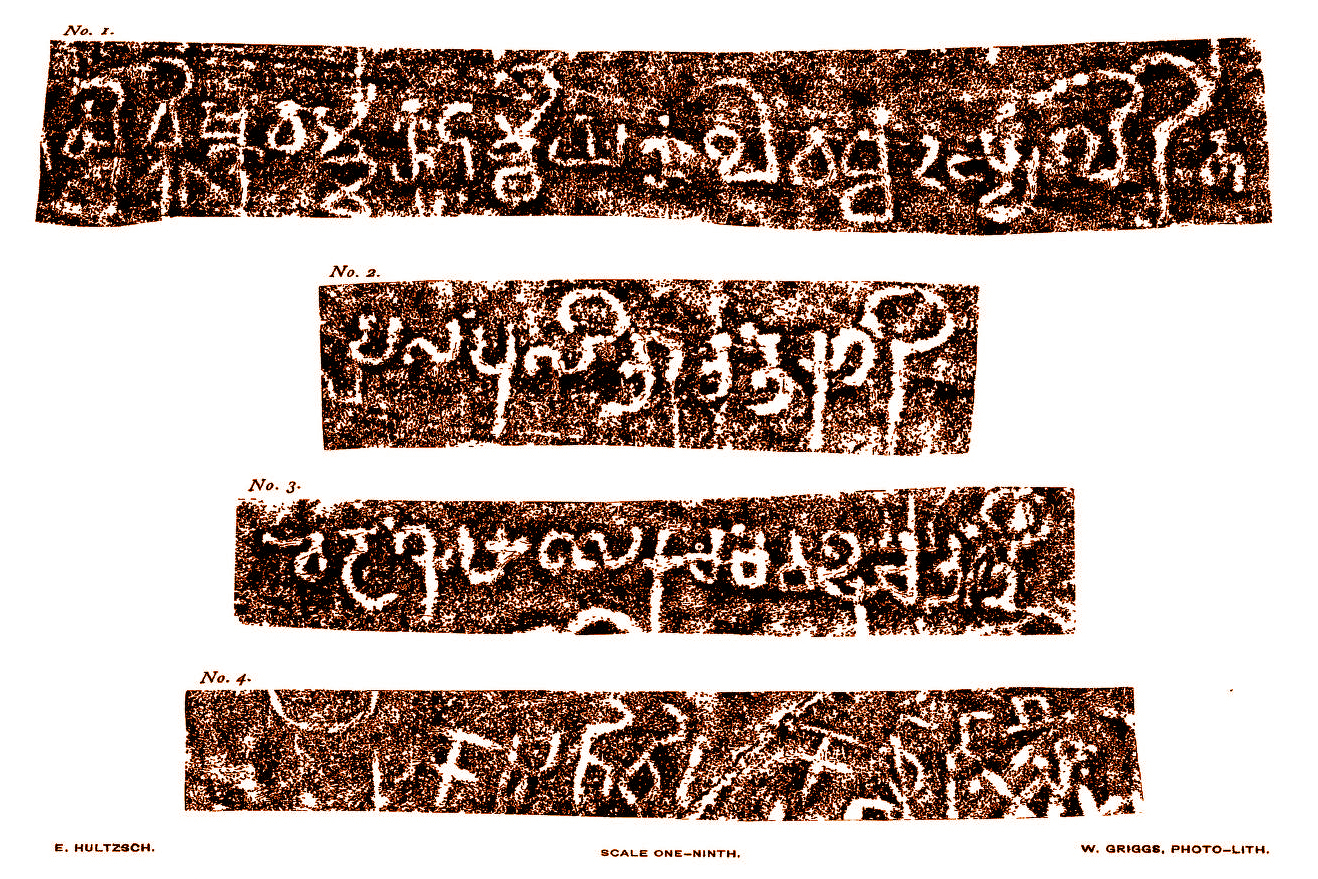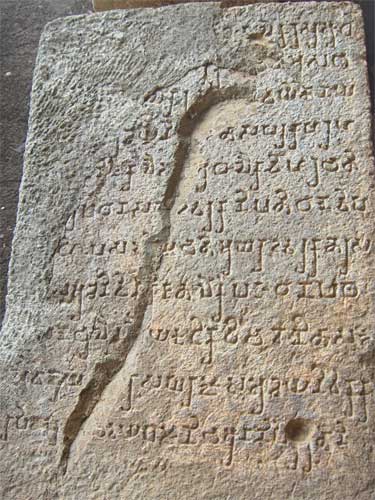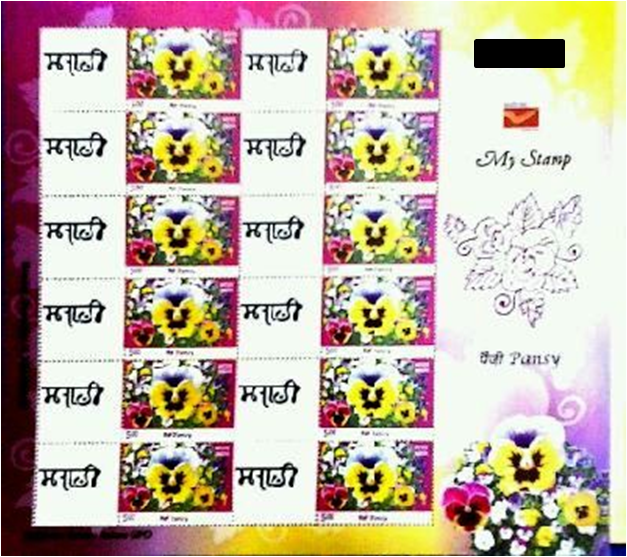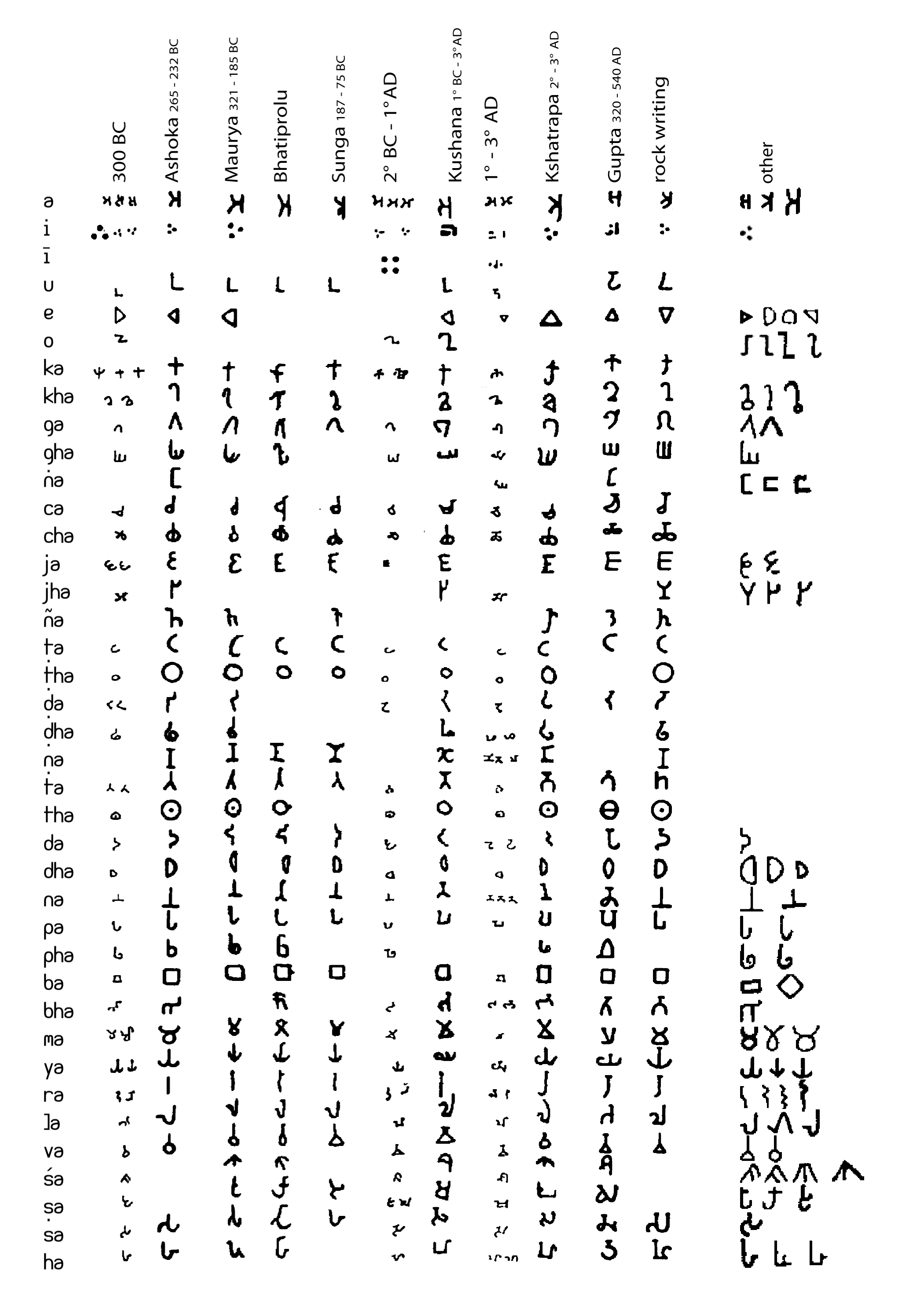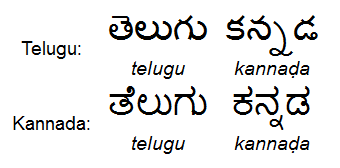|
Goykanadi
or Kandavī is a Brahmic script that was once used in the territory of Goa to write Konkani and sometimes Marathi in the Konkan coast. Similarly, it was used by the trading Saraswat and Daivajna families along with the Modi script to maintain their accounts. Overview Goykanadi was used in Goa since the times of the Kadambas, although it lost its popularity after the 17th century. Goykanadi is very different from the Old Kannada script, with strikingly similar features. Unlike Old Kannada, Kandevi/Goykanadi letters were usually written with a distinctive horizontal bar, like the Nagari scripts. This script may have been evolved out of the Kadamba script, which was extensively used in Goa and Konkan. Usage and extinction The inquisition of Goa is seen as a blot in the history of the Konkani language. According to the orders of the Goa inquisition it was an offence to remain in possession of books in the local languages. All books, whatever their subject matter, written ... [...More Info...] [...Related Items...] OR: [Wikipedia] [Google] [Baidu] |
Konkani Language
Konkani () is an Indo-Aryan language spoken by the Konkani people, primarily in the Konkan region, along the western coast of India. It is one of the 22 scheduled languages mentioned in the Indian Constitution, and the official language of the Indian state of Goa. It is a minority language in Karnataka, Maharashtra, Kerala, Gujarat & Damaon, Diu & Silvassa. Konkani is a member of the Southern Indo-Aryan language group. It retains elements of Vedic structures and shows similarities with both Western and Eastern Indo-Aryan languages. The first Konkani inscription is dated 1187 A.D. There are many Konkani dialects spoken along and beyond the Konkan region, from Damaon in the north to Carwar in the south, most of which are only partially and mutually intelligible with one another due to a lack of linguistic contact and exchanges with the standard and principal forms of Konkani. It is also spoken by migrants outside of the Konkan proper; in Surat, Cochin, Mangalore, ... [...More Info...] [...Related Items...] OR: [Wikipedia] [Google] [Baidu] |
Kadamba Script
The Kadamba script is the first writing system devised specifically for writing Kannada and Telugu. It is a descendant of the Brahmi script. The Kadamba script is also known as ''Pre-Old-Kannada script''. The Kadamba script is one of the oldest of the southern group of Brahmic scripts that evolved from the Brahmi script. By the 5th century CE it became distinct from other Brahmi variants and was used in southern Indian states of Karnataka and Andhra Pradesh. It evolved into the Old Kannada script by the 10th century CE and was used to write Kannada and Telugu Telugu may refer to: * Telugu language, a major Dravidian language of India *Telugu people, an ethno-linguistic group of India * Telugu script, used to write the Telugu language ** Telugu (Unicode block), a block of Telugu characters in Unicode S .... It is also related to the Sinhala script. History During the rule of Kadamba dynasty (325-550), major change in the Brahmi script resulted in the Kadamba Kannada scrip ... [...More Info...] [...Related Items...] OR: [Wikipedia] [Google] [Baidu] |
Kannada Script
The Kannada script ( IAST: ''Kannaḍa lipi''; obsolete: Kanarese or Canarese script in English) is an abugida of the Brahmic family, used to write Kannada, one of the Dravidian languages of South India especially in the state of Karnataka. Kannada script is also widely used for writing Sanskrit texts in Karnataka. Several minor languages, such as Tulu, Konkani, Kodava, Sanketi and Beary, also use alphabets based on the Kannada script. The Kannada and Telugu scripts share very high mutual intellegibility with each other, and are often considered to be regional variants of single script. Other scripts similar to Kannada script are Sinhala script (which included some elements from the Kadamba script), and Old Peguan script (used in Burma). The Kannada script ( ''akṣaramāle'' or ''varṇamāle'') is a phonemic abugida of forty-nine letters. The character set is almost identical to that of other Brahmic scripts. Consonantal letters imply an inherent vowel. Letters ... [...More Info...] [...Related Items...] OR: [Wikipedia] [Google] [Baidu] |
Brahmic Scripts
The Brahmic scripts, also known as Indic scripts, are a family of abugida writing systems. They are used throughout the Indian subcontinent, Southeast Asia and parts of East Asia. They are descended from the Brahmi script of ancient India and are used by various languages in several language families in South, East and Southeast Asia: Indo-Aryan, Dravidian, Tibeto-Burman, Mongolic, Austroasiatic, Austronesian, and Tai. They were also the source of the dictionary order (''gojūon'') of Japanese ''kana''. History Brahmic scripts descended from the Brahmi script. Brahmi is clearly attested from the 3rd century BCE during the reign of Ashoka, who used the script for imperial edicts, but there are some claims of earlier epigraphy found on pottery in southern India and Sri Lanka. The most reliable of these were short Brahmi inscriptions dated to the 4th century BCE and published by Coningham et al. (1996). Northern Brahmi gave rise to the Gupta script during the ... [...More Info...] [...Related Items...] OR: [Wikipedia] [Google] [Baidu] |
Karekar
Karekar is one of the common surnames of the Daivajna community, predominantly residing in Goa, some parts of Karnataka and Maharashtra. They originally hail from ''Caraim'' village on Chorão island in coastal Indian state of Goa.They belong to various brahminical Gotras(Bharadwaja,Kashyapa,Kaushika, Shandilya,Sauparna)and use different surnames and titles and worship ''Gajantalakshmi Ravalanatha'' in the village of Mashel, in Goa as their Tutelary deity. Historically many of them were wealthy merchants who formed themselves into guilds or Shreni, and also functioned as Mahajans (money lenders, patrons of the temples etc.) and ''Ganvkars'' of the Ganvkari system. Citations References * *{{Citation , title = People of India: Goa , last1 = Singh , first1 = Kumar Suresh , last2 = Prakashchandra , first2 = Shirodkar See also * Ravalnath * Shett *Goykanadi or Kandavī is a Brahmic script that was once used in the territory of Goa to write Konkani and sometimes M ... [...More Info...] [...Related Items...] OR: [Wikipedia] [Google] [Baidu] |
Modi Script
Modi ( mr, मोडी, , ; also Mudiya) is a script used to write the Marathi language, which is the primary language spoken in the state of Maharashtra, India. There are multiple theories concerning its origin. The Modi script was used alongside the Devanagari script to write Marathi until the 20th century when the Balbodh style of the Devanagari script was promoted as the standard writing system for Marathi. Etymology The name 'Modi' perhaps derives from the Marathi verb ''moḍaṇe'' (Marathi: मोडणे), which means "to bend or break". Modi is believed to be derived from broken Devanagari characters, which lends support to that particular etymology. It is not to be confused with the name Modi. Origin theories Hemāḍpant origin theory Hemāḍpant was a minister during the reign of Mahadeva (ruled 1261–1271) and the initial years of the reign of Rāmachandra (ruled 1271 to 1309) of the Yadava Dynasty. Creation subtheory Hemāḍpant created the ... [...More Info...] [...Related Items...] OR: [Wikipedia] [Google] [Baidu] |
Daivajna
The Daivadnyas, (also known as Daivadnya Brahmins or Daivadnya Sonars or Konkanastha Rathakara), are a Konkani Gold-smith community, who claim to have descended from Vishwakarma, Hindu architect god and part of larger Vishwakarma community. They are native to the Konkan and are mainly found in the states of Goa and Damaon, Canara (coastal Karnataka), coastal Maharashtra, and Kerala. Daivadnyas are a subgroup of Sonars (Gold Smiths) and hence they are called as Daivadnya Sonars or ''Suvarṇakara'' or simply Sonar. Daivadnya Sonars in Maharashtra claim to be Brahmins and call themselves as Daivadnya Brahmins however this is not accepted by the Brahmins there. The Poona government did not accept the claim either but the Bombay Sonars continued with the claim.However, Oliver Godsmark, a researcher on late colonial and early postcolonial South Asia, considers them a subcaste of the Brahmins that were originally from the coastal regions of Maharashtra, Karnataka and Goa. T ... [...More Info...] [...Related Items...] OR: [Wikipedia] [Google] [Baidu] |
Brahmic Script
The Brahmic scripts, also known as Indic scripts, are a family of abugida writing systems. They are used throughout the Indian subcontinent, Southeast Asia and parts of East Asia. They are descended from the Brahmi script of ancient India and are used by various languages in several language families in South, East and Southeast Asia: Indo-Aryan, Dravidian, Tibeto-Burman, Mongolic, Austroasiatic, Austronesian, and Tai. They were also the source of the dictionary order (''gojūon'') of Japanese ''kana''. History Brahmic scripts descended from the Brahmi script. Brahmi is clearly attested from the 3rd century BCE during the reign of Ashoka, who used the script for imperial edicts, but there are some claims of earlier epigraphy found on pottery in southern India and Sri Lanka. The most reliable of these were short Brahmi inscriptions dated to the 4th century BCE and published by Coningham et al. (1996). Northern Brahmi gave rise to the Gupta script during the Gupt ... [...More Info...] [...Related Items...] OR: [Wikipedia] [Google] [Baidu] |
Bhattiprolu Script
The Bhattiprolu script is a variant of the Brahmi script which has been found in old inscriptions at Bhattiprolu, a small village in Guntur district, Andhra Pradesh, South India. It is located in the fertile Krishna river delta and the estuary region where the river meets the Bay of Bengal. The inscriptions date to between the 3rd and 1st centuries BCE, putting them among the earliest evidence of Brahmi writing in South India. Bhattiprolu differs from Ashokan Brahmi in two significant ways. First, the letters ''gh, j, m, l, s'' are "radically different": ''m'' is upside-down compared to Brahmi, while ''gh'' appears to derive from ''g'' rather than from Semitic ''heth''. Secondly, the inherent vowel has been discarded: A consonant written without diacritics represents the consonant alone. This is unique to Bhattiprolu and Tamil Brahmi among the early Indian scripts. Discovery Excavations that started in the year 1870 by Boswell, Sir Walter Elliot, Robert Sewell, Alexand ... [...More Info...] [...Related Items...] OR: [Wikipedia] [Google] [Baidu] |
Brahmi Script
Brahmi (; ; ISO 15919, ISO: ''Brāhmī'') is a writing system of ancient South Asia. "Until the late nineteenth century, the script of the Aśokan (non-Kharosthi) inscriptions and its immediate derivatives was referred to by various names such as 'lath' or 'Lat', 'Southern Aśokan', 'Indian Pali', 'Mauryan', and so on. The application to it of the name Brahmi [''sc. lipi''], which stands at the head of the Buddhist and Jaina script lists, was first suggested by T[errien] de Lacouperie, who noted that in the Chinese Buddhist encyclopedia ''Fa yiian chu lin'' the scripts whose names corresponded to the Brahmi and Kharosthi of the ''Lalitavistara'' are described as written from left to right and from right to left, respectively. He therefore suggested that the name Brahmi should refer to the left-to-right 'Indo-Pali' script of the Aśokan pillar inscriptions, and Kharosthi to the right-to-left 'Bactro-Pali' script of the rock inscriptions from the northwest." that appeared as a full ... [...More Info...] [...Related Items...] OR: [Wikipedia] [Google] [Baidu] |
Telugu-Kannada Alphabet
The Kannada–Telugu script (or Telugu–kannada script) was a writing system used in Southern India. Despite some differences, the scripts used for the Kannada and Telugu languages remain quite similar and highly mutually intelligible. History The Dravidian family comprises about 73 languages including Tamil, Kannada, Telugu and Malayalam. Satavahanas introduced the Brahmi to present-day Telugu and Kannada speaking regions. Bhattiprolu script introduced by the Satavahanas gave rise to the Kadamba script. During the 5th to 7th centuries the early Bādāmi Chālukyās and Early Banavasi Kadambās used an early form of the Kannada script in inscriptions, called the Kadamba script. The Kadamba script evolved into the Kannada script. When Chalukya empire extended towards Telugu speaking regions they establihed another branch in Vengi, namely the Eastern Chalukyas or the Chalukyas of Vengi who later introduced Kannada script to Telugu language which devloped Kannada-Telugu scr ... [...More Info...] [...Related Items...] OR: [Wikipedia] [Google] [Baidu] |

